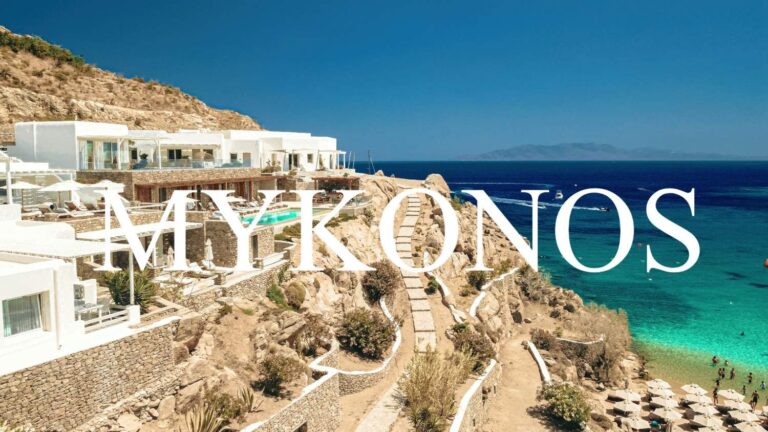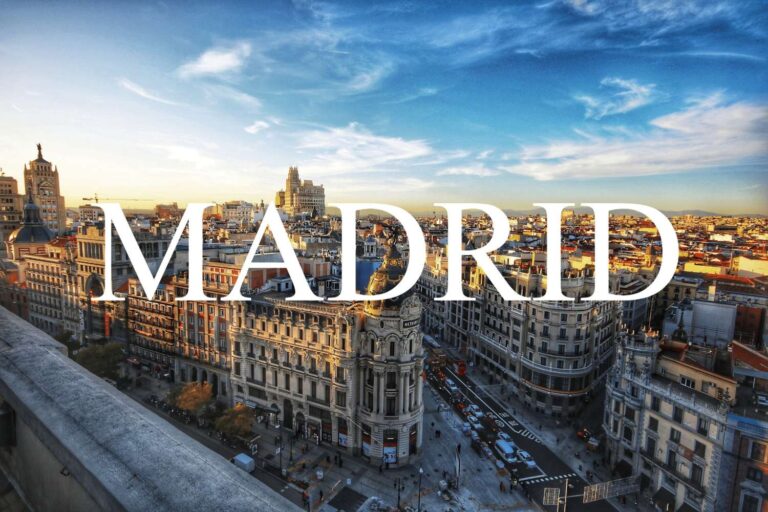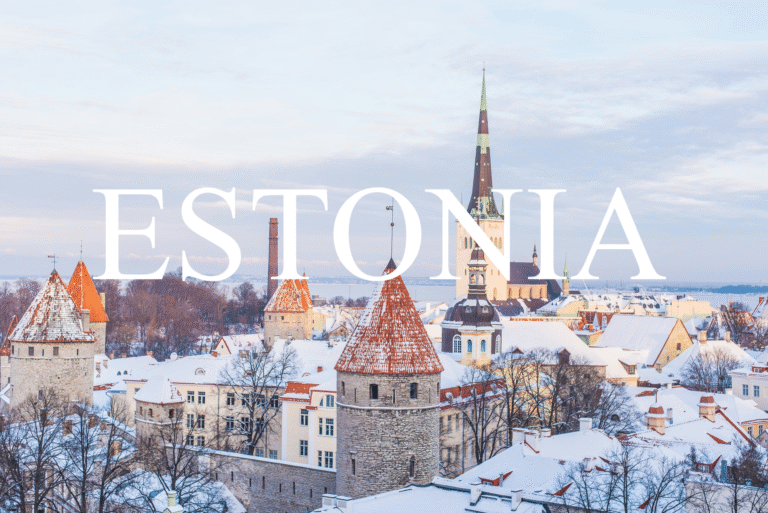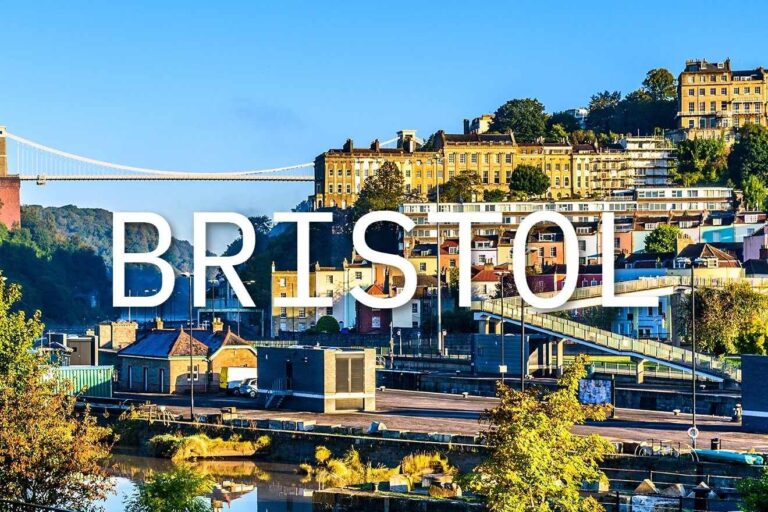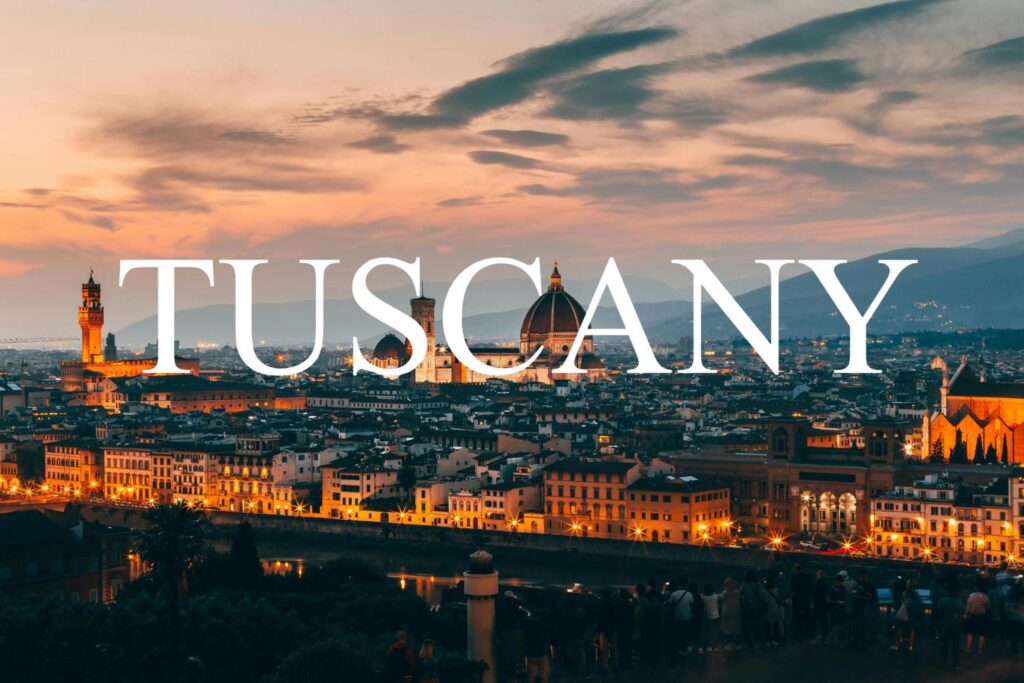
If Italy is a love song, Tuscany is undoubtedly its most romantic verse. With its rolling hills draped in golden light, cypress-lined roads, medieval hilltop towns, and world-renowned wines, Tuscany captures the essence of la dolce vita. It’s a place where history and nature blend effortlessly, offering travelers an unforgettable journey through the soul of Italy.
From the Renaissance grandeur of Florence, the region’s artistic crown jewel, to the tranquil countryside dotted with stone farmhouses and sun-soaked vineyards, Tuscany feels like a postcard come to life. Walk in the footsteps of da Vinci and Michelangelo in Florence’s galleries, then escape to the serene charm of villages like San Gimignano, Montepulciano, and Pienza, where time seems to slow down.
Tuscany is a dream for wine lovers and food enthusiasts. Explore the lush vineyards of Chianti, Brunello di Montalcino, or Vino Nobile di Montepulciano, where passionate winemakers offer tastings and stories passed down through generations. Pair your glass with local flavors like pecorino cheese, wild boar ragù, hand-rolled pici pasta, and olive oil that’s among the finest in the world.
For those craving romance and relaxation, Tuscany delivers with breathtaking sunsets over Val d’Orcia, peaceful stays in agriturismos (farm stays), and leisurely afternoons soaking in natural hot springs in towns like Saturnia or Bagno Vignoni. Whether you’re on a honeymoon, anniversary, or simply seeking tranquility, Tuscany wraps you in its warm embrace.
Adventurers can hike the Apennine Mountains, cycle through winding country roads, or explore the coastlines and islands of the Tuscan Archipelago. Every turn reveals another layer of the region’s diverse beauty.
Whether you’re following a scenic road trip, indulging in a wine-and-dine escape, or immersing yourself in Renaissance art and architecture, Tuscany is a place where every moment feels poetic. It’s not just a destination—it’s a feeling you carry long after you’ve returned home.
🌄 Top Places to Visit in Tuscany
Florence (Firenze)
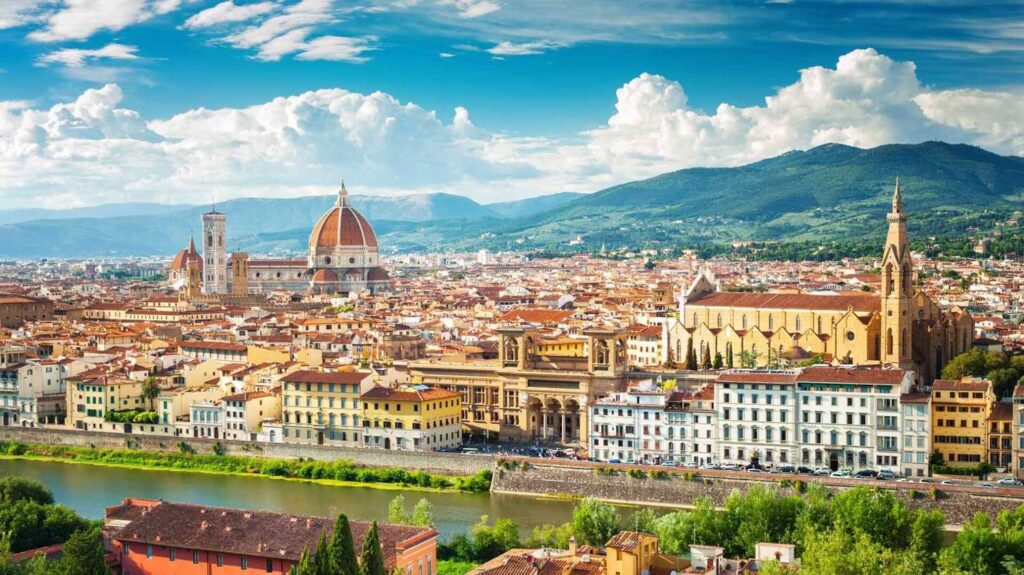
Nestled in the heart of Tuscany, Florence (Firenze) is a city that feels like an open-air museum. Known as the birthplace of the Renaissance, Florence boasts an unmatched collection of art, architecture, and culture. With its cobbled streets, historic palaces, and legendary masterpieces by Michelangelo, Da Vinci, and Botticelli, Florence invites travelers to step back in time while enjoying world-class cuisine and vibrant Italian life.
🌟 Highlights of Florence
• 🎨 The Uffizi Gallery:
Home to some of the world’s most celebrated art, including Botticelli’s The Birth of Venus and da Vinci’s Annunciation, the Uffizi is a must-visit for any art lover. Its corridors are a journey through centuries of creativity.
• 🏰 Florence Cathedral (Il Duomo):
Dominating the city skyline, the Cathedral of Santa Maria del Fiore, with Brunelleschi’s red-tiled dome, is a masterpiece of Gothic and Renaissance architecture. Climb to the top for panoramic views of Florence.
• 🖼️ Galleria dell’Accademia:
This is where you’ll find Michelangelo’s David, perhaps the most iconic sculpture in the world. The museum also features other Renaissance works and musical instruments.
• 🌉 Ponte Vecchio:
Florence’s most famous bridge, Ponte Vecchio is lined with goldsmith shops and jewelers, and it spans the Arno River with medieval charm. A stroll here at sunset is pure magic.
• 🏛️ Palazzo Pitti & Boboli Gardens:
Once the residence of the powerful Medici family, this grand palace houses impressive art galleries and opens onto the beautifully landscaped Boboli Gardens—perfect for a peaceful walk and spectacular views.
🚶 How to Get There
• By Train:
Florence is easily accessible by Italy’s high-speed trains. The Santa Maria Novella (SMN) station is just a short walk from most major attractions.
• By Car:
While driving in the city center can be tricky due to ZTL (limited traffic zones), Florence is well-connected via highways to Pisa, Rome, and Venice.
• By Air:
Florence Airport (Peretola) is small but convenient. Alternatively, many visitors fly into Pisa or Bologna and take a train or bus to Florence.
🕒 Visitor Information
• Best Time to Visit:
- Spring (April–June) and Fall (September–October) offer ideal weather with fewer crowds.
- Summer is hot and busy, while winter is quiet but charming, especially around Christmas.
• Time Needed to Explore:
Spend at least 2–3 full days in Florence to see the highlights without rushing. Art lovers could easily spend a week here.
• Opening Hours:
- Museums typically open 9:00 AM – 6:30 PM, with Mondays often being a closure day.
- Churches may close midday or during services—check schedules in advance.
💡 Travel Tips
• 🎟️ Book in Advance:
Major attractions like the Uffizi and Accademia often have long lines. Pre-book tickets online to skip the wait.
• 👟 Wear Comfortable Shoes:
Florence is best explored on foot, and many streets are cobblestone—good shoes are a must.
• 🍦 Taste Local Delights:
Try bistecca alla fiorentina, ribollita, and gelato from a local artisan shop. Don’t forget to sip some Chianti wine with your meal.
• 📷 Sunset Spots:
Head to Piazzale Michelangelo or San Miniato al Monte for stunning sunset views over the Florence skyline.
• 🛍️ Leather Goods & Artisan Crafts:
Florence is famous for its handmade leather products and gold jewelry—browse the San Lorenzo Market for souvenirs.
Florence is a city that touches your soul and ignites your imagination. Whether you’re marveling at a Michelangelo sculpture, sipping espresso in a sun-dappled piazza, or watching the Arno shimmer at dusk, Florence delivers a timeless experience. With its deep cultural roots and warm Italian hospitality, Firenze is not just a destination—it’s a feeling you’ll carry long after your visit.
Siena
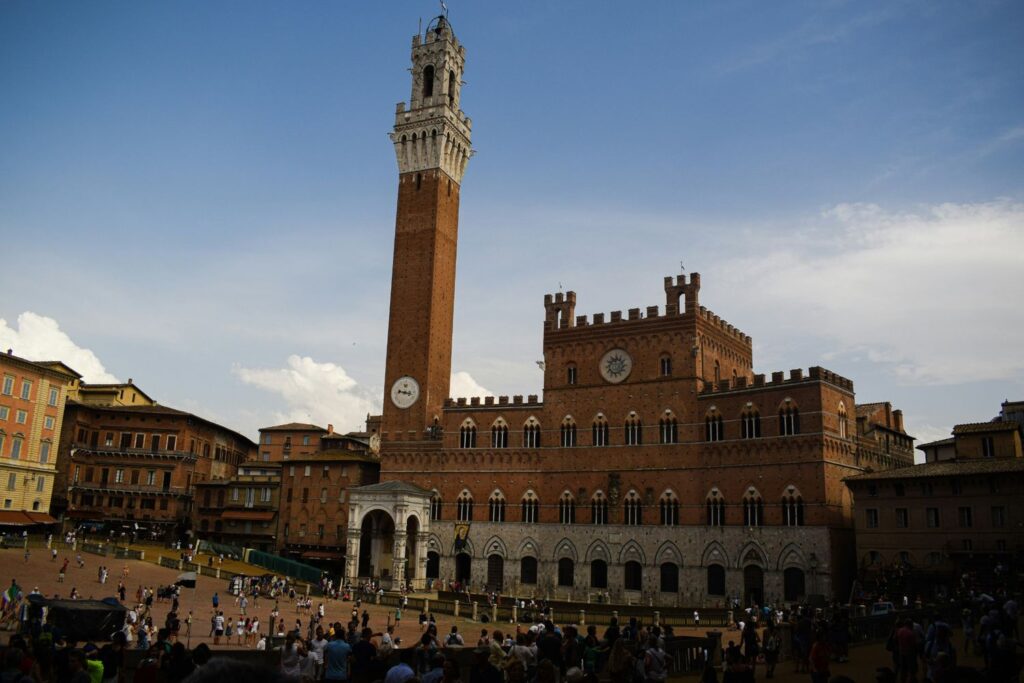
Photo by Mateus Campos Felipe on Unsplash
Nestled among the rolling hills of central Tuscany, Siena is a beautifully preserved medieval city that feels like stepping into a fairytale. Known for its Gothic architecture, cobblestone streets, and the world-famous Palio horse race, Siena offers a rich blend of history, culture, and authentic Italian charm. With its red-brick buildings, dramatic piazzas, and slower pace, Siena is an essential stop for anyone exploring the heart of Italy.
🌟 Highlights of Siena
• 🏛️ Piazza del Campo:
Siena’s stunning shell-shaped main square is one of Europe’s most unique public spaces. This is the heartbeat of the city and the location of the Palio di Siena, a thrilling bareback horse race held twice a year. Enjoy a cappuccino at a terrace café while soaking in the medieval atmosphere.
• ⛪ Siena Cathedral (Duomo di Siena):
A masterpiece of Italian Romanesque-Gothic architecture, the Siena Cathedral features black and white marble, stunning frescoes, and the famous Piccolomini Library. Don’t miss climbing up to the Facciatone viewpoint for panoramic city views.
• 🖼️ Museo dell’Opera del Duomo:
Located next to the cathedral, this museum houses original artworks from the Duomo, including sculptures by Donatello and Duccio. It’s a quiet treasure trove for art and history lovers.
• 🏰 Palazzo Pubblico & Torre del Mangia:
This 13th-century city hall faces Piazza del Campo and includes the Civic Museum with frescoes by Ambrogio Lorenzetti. Climb the Torre del Mangia for one of the best views in Tuscany—worth every step.
• 🏛️ Santa Maria della Scala:
Once a hospital for pilgrims, this historic complex is now a cultural center and museum featuring archaeological finds, religious art, and rotating exhibits. It’s one of Italy’s oldest hospitals turned into one of Siena’s most impressive attractions.
🚶 How to Get There
• By Train:
Siena is about 1.5 hours by train from Florence. The train station is located downhill from the city center, but buses and escalators make the journey up convenient.
• By Car:
A scenic drive through Tuscany’s countryside leads you to Siena. Be aware of ZTL zones in the historic center—park outside the walls and walk in.
• By Bus:
Direct buses from Florence and other Tuscan towns drop you closer to the city center than the train does, making it a good option for day trips.
🕒 Visitor Information
• Best Time to Visit:
- Spring (April–June) and Fall (September–October) offer ideal temperatures and fewer crowds.
- July and August can be hot and busy, especially during the Palio.
• Palio di Siena:
- Held on July 2 and August 16, this centuries-old horse race is a spectacle of local pride, pageantry, and adrenaline. Book well in advance if visiting during these dates.
• Time Needed to Explore:
A day is enough for the highlights, but spending 2–3 days allows for deeper exploration, especially if you enjoy art, history, and Tuscan cuisine.
💡 Travel Tips
• 🎫 Buy Combo Tickets:
Many of Siena’s top attractions offer combined entry tickets, saving you time and money. Look for the OPA Si Pass for the Duomo complex.
• 👟 Wear Comfortable Shoes:
Siena’s hilly terrain and stone streets can be challenging—good walking shoes are essential.
• 🍷 Try the Local Wine:
Siena is near some of Italy’s top wine regions, including Chianti and Brunello di Montalcino. Wine bars and restaurants often offer tasting flights.
• 🍝 Local Dishes to Try:
Sample pici pasta (a thick hand-rolled noodle), ribollita (Tuscan bread soup), and panforte, a dense spiced fruitcake that originated in Siena.
• 🛍️ Artisan Souvenirs:
Siena is known for its ceramics, leather goods, and traditional sweets. Browse local shops tucked away in narrow alleys for unique gifts.
Siena offers a different flavor of Tuscany—quietly regal, steeped in history, and deeply rooted in local tradition. Whether you’re walking the medieval alleys, tasting rustic Tuscan food, or cheering during the Palio, Siena delivers an unforgettable journey into Italy’s soul. It’s not just a stop on a Tuscan itinerary—it’s an experience all its own.
Chianti Wine Region
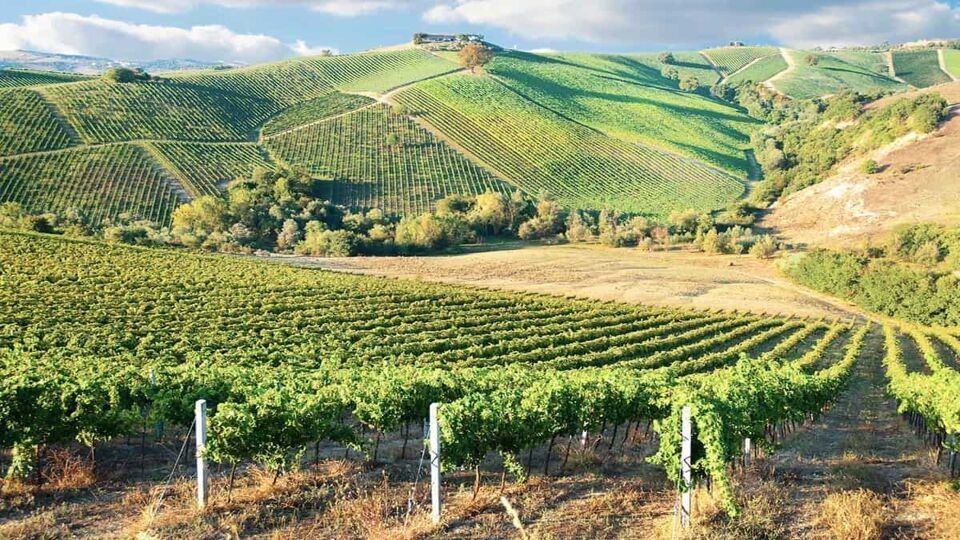
Tucked between the historic cities of Florence and Siena, the Chianti Wine Region is a picturesque stretch of Tuscany that feels like it’s been lifted straight from a postcard. With its rolling hills draped in vineyards, centuries-old stone farmhouses, and winding roads lined with cypress trees, Chianti is a dream for wine lovers, foodies, and romantics alike. Known globally for its iconic Chianti Classico wine, this region is as much about the slow pace of life as it is about savoring every glass and every view.
🌟 Highlights of the Chianti Wine Region
• 🍇 Chianti Classico Wine Trail
Explore the heart of Chianti by following the Strada del Vino Chianti Classico, a scenic wine route that winds through historic villages like Greve in Chianti, Radda, and Castellina. Stop at family-owned wineries to sample robust reds, meet passionate winemakers, and tour centuries-old cellars.
• 🏞️ Greve in Chianti
Often considered the gateway to Chianti, Greve boasts a charming piazza, wine museums, and excellent enotecas (wine bars). It’s a great base for tastings and countryside explorations.
• 🏰 Castellina in Chianti
This hilltop village offers stunning views, Etruscan ruins, and a medieval fortress. Wander through cobblestone lanes, browse artisan shops, and enjoy a glass of wine overlooking the Tuscan hills.
• 🍷 Wine Tasting & Vineyard Tours
Chianti is dotted with renowned wineries like Castello di Ama, Castello di Brolio, and Antinori nel Chianti Classico. Book a tasting tour to learn about the winemaking process, stroll through ancient vineyards, and enjoy curated pairings with local cheeses and cured meats.
• 🧀 Farm-to-Table Experiences
Savor Chianti’s rural flavors with agriturismo stays and farmhouse lunches. Enjoy dishes made from local ingredients—think fresh pecorino, wild boar ragu, and handmade pasta—all paired with house wines.
🚗 How to Get There
• By Car:
Driving is the best way to explore Chianti at your own pace. From Florence or Siena, scenic country roads lead you deep into the region. Be prepared for winding roads and take your time—this journey is as much about the drive as the destination.
• By Tour:
Wine tours from Florence or Siena offer a hassle-free way to discover Chianti. These often include transportation, guided tastings, and lunch in a vineyard.
• By Public Transport:
While less flexible, buses connect major towns like Greve and Castellina. However, renting a car or joining a tour offers a much richer experience.
🕒 Visitor Information
• Best Time to Visit:
– Spring (April–June) and Fall (September–October) are ideal, with mild weather, grape harvests, and fewer tourists.
– Autumn, especially September, is perfect for wine festivals and harvest tours.
– Summer is vibrant but can be hot and more crowded.
• Time Needed to Explore:
A full day lets you taste and tour, but staying 2–3 days allows for deeper immersion, especially if you’re visiting multiple wineries or towns.
• Festivals to Catch:
– Chianti Classico Wine Festival (Greve, September) – Sample local wines and meet producers in a festive, open-air setting.
– Radda nel Bicchiere (May/June) – A wine-tasting event in the charming town of Radda in Chianti.
💡 Travel Tips
• 🍷 Understand the Labels:
Look for bottles with the Gallo Nero (Black Rooster) seal—this marks an authentic Chianti Classico.
• 🧳 Pack for the Countryside:
Wear comfortable shoes for walking vineyards and villages, and pack light layers for cool evenings.
• 🍝 Local Dishes to Try:
Savor dishes like pici pasta with ragu, bistecca alla fiorentina, and ribollita, a hearty Tuscan soup. Don’t miss cantucci e vin santo—almond cookies dipped in sweet dessert wine.
• 🛍️ Souvenirs to Bring Home:
Chianti wine, hand-painted ceramics, local olive oil, and cured meats make perfect gifts (or treats for yourself).
• 📸 Scenic Stops:
Pull over for photo ops—sunsets over vineyards, stone farmhouses, and panoramic viewpoints are everywhere.
The Chianti Wine Region is more than just a destination—it’s a sensory experience that captures the essence of Tuscany. Whether you’re sipping Sangiovese under the Tuscan sun, walking through vine-covered hills, or dining on rustic local fare, Chianti invites you to slow down and savor the simple pleasures of Italian life. It’s a journey best taken one glass—and one vista—at a time.
San Gimignano
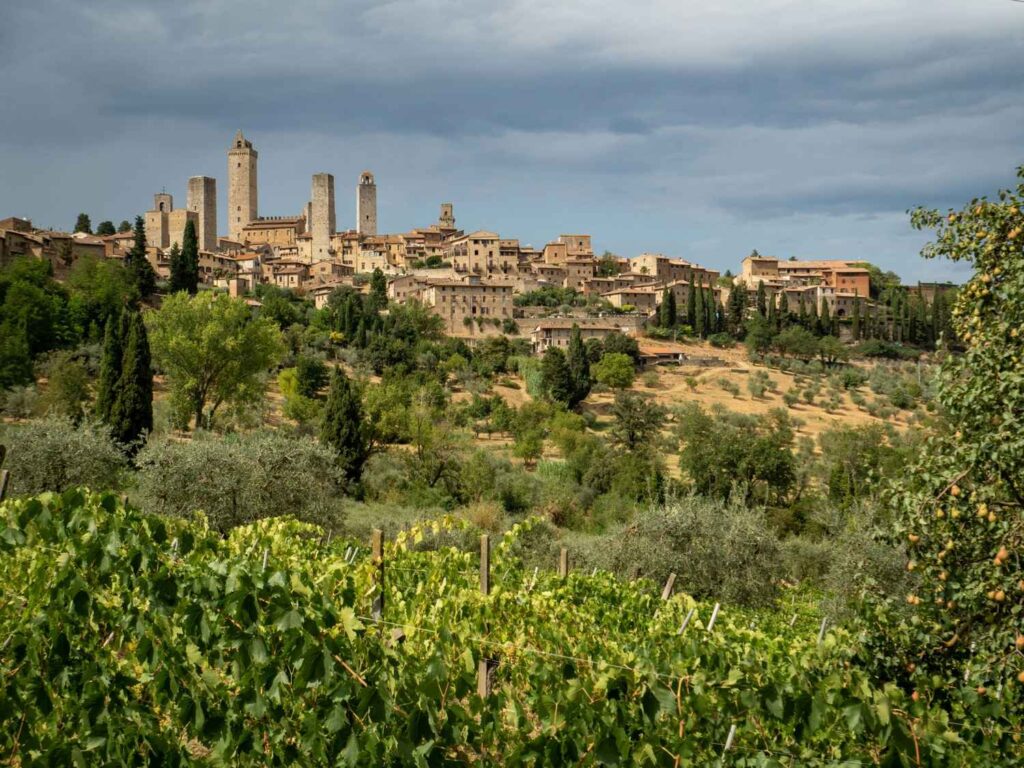
Set atop a hill in the heart of Tuscany, San Gimignano is a small walled town known for its stunning medieval architecture and dramatic skyline of ancient towers. Often called the “Medieval Manhattan”, this UNESCO World Heritage Site transports visitors back to the 13th century with its well-preserved streets, artisanal shops, and breathtaking countryside views. Whether you’re a history buff, a wine lover, or simply seeking a romantic escape, San Gimignano delivers an unforgettable Italian experience.
🌟 Highlights of San Gimignano
• 🗼 The Towers of San Gimignano:
Originally there were 72 towers built by feuding noble families to showcase wealth and power. Today, 14 towers still stand, giving the town its iconic skyline. Climb Torre Grossa, the tallest at 54 meters, for panoramic views of the Tuscan countryside.
• ⛪ Collegiata di Santa Maria Assunta (San Gimignano Cathedral):
This Romanesque cathedral may look modest on the outside, but inside it’s filled with stunning frescoes depicting biblical scenes by artists like Taddeo di Bartolo and Benozzo Gozzoli.
• 🖼️ Civic Museum & Palazzo del Popolo:
Housed inside the Town Hall, this museum features a rich collection of artwork and historical artifacts. Don’t miss the Room of the Podestà and its fascinating frescoes on love and courtship.
• 🍷 Vernaccia Wine Tasting:
San Gimignano is the birthplace of Vernaccia di San Gimignano, a crisp white wine with a DOCG designation. Many wine shops and vineyards offer tastings and pairings with local cheese and salumi.
• 🖌️ San Gimignano 1300 Museum:
A unique, miniature ceramic model of the town as it looked in the 14th century, offering a hands-on, immersive look at medieval life.
🚶 How to Get There
• By Car:
The most convenient way to reach San Gimignano is by car. It’s about a 1-hour drive from Florence or Siena. Parking is available just outside the town walls.
• By Bus:
Buses run from Florence and Siena, though you may need to transfer in Poggibonsi. The bus drops you off a short walk from the main gate.
• By Tour:
Many guided day tours from Florence or Siena include San Gimignano, often paired with Chianti vineyards or nearby towns like Volterra.
🕒 Visitor Information
• Best Time to Visit:
- Spring (April–June) and Fall (September–October) offer the best weather with fewer crowds.
- Summer is popular but can be hot and busy, especially in July and August.
• Time Needed to Explore:
You can experience the highlights in half a day, but spending a full day allows time for relaxed sightseeing, wine tasting, and soaking in the scenery.
• Opening Hours:
- Most attractions and museums are open from 10:00 AM to 6:00 PM, though hours may vary seasonally.
- Shops typically close for lunch from 1:00 PM to 3:00 PM.
💡 Travel Tips
• 📸 Photography Paradise:
Visit early in the morning or near sunset for the best lighting and fewer crowds—ideal for capturing the town’s charm.
• 👟 Wear Walking Shoes:
San Gimignano’s streets are cobbled and hilly. Comfortable shoes make exploring much more enjoyable.
• 🍨 Try the World-Famous Gelato:
Stop by Gelateria Dondoli, a multi-time world champion gelateria in Piazza della Cisterna, for an unforgettable treat.
• 🎁 Local Souvenirs:
Look for saffron products, hand-painted ceramics, and bottles of Vernaccia wine to take a piece of Tuscany home with you.
• 🧀 Food Tip:
Enjoy local specialties like wild boar pasta (pappardelle al cinghiale), truffle dishes, and pecorino cheese at a trattoria with vineyard views.
San Gimignano may be small, but its history, charm, and dramatic towers leave a lasting impression. Whether you’re enjoying a glass of Vernaccia on a sunlit terrace, exploring centuries-old frescoes, or simply wandering its winding lanes, this timeless town is a gem of Tuscany. Ideal for a romantic escape or a cultural adventure, San Gimignano invites you to slow down and savor the beauty of the past—one tower at a time.
Pisa
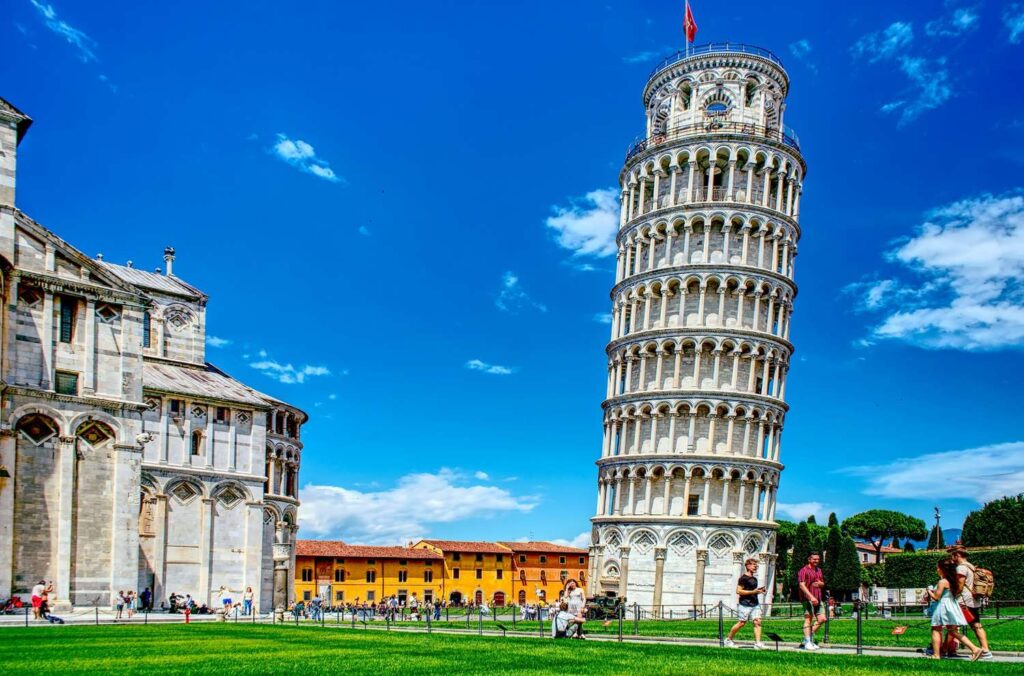
Photo by Andrea Cevenini on Unsplash
Located along the banks of the Arno River in western Tuscany, Pisa is world-famous for its iconic Leaning Tower, but this historic university city offers much more than just one photo opportunity. From medieval churches and vibrant street life to hidden courtyards and local trattorias, Pisa blends academic energy with centuries of art, architecture, and tradition. It’s compact, walkable, and packed with charm—perfect for a day trip or a relaxing overnight stay.
🌟 Highlights of Pisa
• 🏗️ Leaning Tower of Pisa (Torre Pendente)
An icon of Italy and one of the most recognized structures in the world, the Leaning Tower is the bell tower of the Cathedral of Santa Maria Assunta. Climb its 294 spiral steps for stunning views of the city—just don’t forget to snap that classic “holding up the tower” photo on the lawn below!
• ⛪ Piazza dei Miracoli (Square of Miracles)
This UNESCO World Heritage Site is home to Pisa’s architectural crown jewels: the Duomo (Cathedral), the Baptistery, the Camposanto Monumentale, and the Leaning Tower. The white marble buildings set against green lawns create a breathtaking scene—especially at sunset.
• 🖼️ Museo dell’Opera del Duomo
Often overlooked, this museum just off the square houses sculptures, relics, and original architectural elements from the cathedral complex. It’s a peaceful, enriching stop away from the crowds.
• 🎓 Piazza dei Cavalieri
Once the political heart of the medieval city, this elegant square is now dominated by the Scuola Normale Superiore, one of Italy’s most prestigious universities. Admire the Palazzo della Carovana, decorated with sgraffito designs by Vasari.
• 🌉 Arno River Walks
Stroll along the riverbanks for a quieter, more local view of Pisa. Cross the Ponte di Mezzo and enjoy cafés, artisan shops, and street art in the Borgo Stretto district.
🚗 How to Get There
• By Train:
Pisa is well-connected, with frequent direct trains from Florence (1 hour), Lucca (30 minutes), and Rome (3 hours). Pisa Centrale is the main station, about 20 minutes on foot from the Leaning Tower.
• By Air:
Pisa International Airport (Galileo Galilei) is just a few kilometers from the city center, with buses and taxis readily available.
• By Car:
Driving is convenient for those touring Tuscany. Parking lots are located outside the historical center—look for signs to Parcheggio di Via Pietrasantina.
🕒 Visitor Information
• Best Time to Visit:
– Spring (April–June) and Fall (September–October) offer pleasant weather and fewer crowds.
– Summer is peak tourist season—expect lines, but also vibrant festivals and long daylight hours.
• Time Needed to Explore:
A half-day covers the main sites, but staying 1–2 days lets you uncover Pisa’s lesser-known treasures and enjoy its relaxed nightlife.
• Opening Hours & Tickets:
– Entrance to the cathedral is free, but timed tickets are required.
– Climbing the Leaning Tower requires a paid ticket and advanced booking, especially in high season.
– Consider the Piazza dei Miracoli combo ticket for access to all major monuments.
💡 Travel Tips
• 📷 Photo Timing:
Visit early morning or late afternoon to avoid crowds and get the best light for photos, especially around the Leaning Tower.
• 🧳 Pack Light:
If you’re stopping through Pisa as part of a longer journey, use the luggage storage near the train station or tower area.
• 🍝 What to Eat:
Try cecina (a chickpea flatbread), Pisan-style tripe, and local seafood dishes. Don’t miss Torta co’ bischeri, a traditional pastry filled with chocolate, rice, and nuts.
• 🍷 Local Wine:
Pisa lies near the Colline Pisane DOC, producing crisp whites and light reds. Many restaurants offer local wines by the glass.
• 🛍️ Souvenirs to Bring Home:
Pick up handmade Tuscan ceramics, Pisa-themed prints, or local olive oil. Markets around Piazza delle Vettovaglie offer authentic finds.
While it may be best known for its world-famous tower, Pisa is far more than a photo stop. With its deep-rooted history, vibrant student life, and riverside charm, Pisa invites you to slow down and explore beyond the obvious. Whether you’re climbing historic towers, sipping wine by the Arno, or uncovering ancient art, Pisa delivers a perfect blend of culture, curiosity, and Tuscan soul.
Lucca
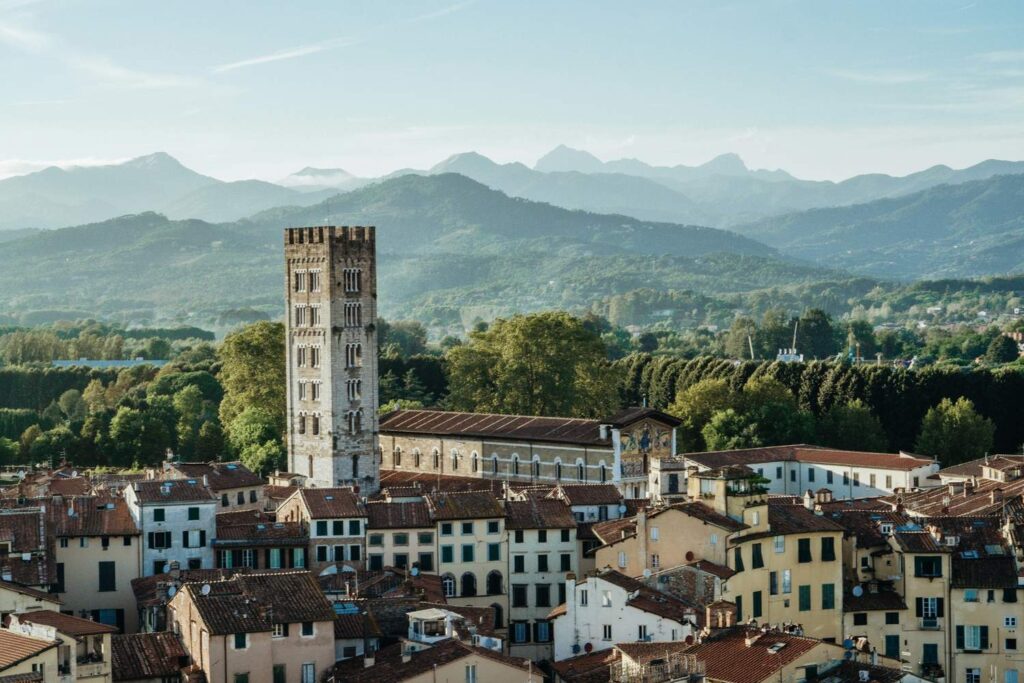
Photo by Kateryna Senkevych on Unsplash
Tucked away in northwest Tuscany, Lucca is a serene, walled city that offers a perfect blend of medieval charm, Renaissance beauty, and relaxed Italian living. Known for its intact city walls, peaceful piazzas, and elegant churches, Lucca is often overlooked in favor of its more famous neighbors—yet it’s precisely this understated allure that makes it so special. Whether you’re cycling on the ramparts or sipping espresso in a sun-drenched square, Lucca is the kind of place that invites you to slow down and savor every moment.
🌟 Highlights of Lucca
• 🚲 The Renaissance Walls:
Lucca’s most iconic feature is its perfectly preserved 16th-century walls that wrap around the city for 4.2 km (2.6 miles). Today, they serve as a tree-lined pedestrian and bike path, offering spectacular views of the city and countryside.
• ⛪ Lucca Cathedral (Duomo di San Martino):
This Romanesque masterpiece is home to the Volto Santo, a sacred wooden crucifix believed to have miraculous origins, and beautiful artworks by renowned Italian artists, including Tintoretto.
• 🕍 Piazza dell’Anfiteatro:
Built on the site of a Roman amphitheater, this elliptical square is a unique architectural gem. It’s surrounded by colorful buildings and filled with cafes—perfect for people-watching with a cappuccino in hand.
• 🏛️ Torre Guinigi:
Climb this medieval tower, famous for the oak trees growing on its rooftop, for sweeping views over Lucca’s terracotta rooftops and green countryside.
• 🎵 Puccini’s Birthplace:
Opera lovers will want to visit Casa di Puccini, the former home of Giacomo Puccini, one of Italy’s greatest composers, where you can see personal items, manuscripts, and his piano.
🚶 How to Get There
• By Train:
Lucca is well-connected by train and just 1.5 hours from Florence and 30 minutes from Pisa. The train station is conveniently located just outside the city walls.
• By Car:
If you’re driving through Tuscany, Lucca makes an easy stop. Park outside the walls, as the historic center is a ZTL zone (limited traffic area).
• By Bus:
There are regional buses from nearby towns, though the train is generally faster and more comfortable.
🕒 Visitor Information
• Best Time to Visit:
- Spring (April–June) and Fall (September–October) offer ideal weather for exploring on foot or by bike.
- July and August are warmer but often include concerts and festivals.
• Opening Hours:
- Major sites like the cathedral, towers, and museums are generally open from 10:00 AM to 6:00 PM, though times may vary seasonally.
- Many shops and restaurants close for a few hours in the afternoon.
• Time to Explore:
You can see Lucca’s main highlights in one day, but spending a night or two allows for deeper discovery and a more relaxed pace.
💡 Travel Tips
• 🚲 Rent a Bike:
One of the best ways to experience Lucca is by cycling the city walls. Bike rental shops are easy to find near the main gates.
• 🥾 Explore Side Streets:
Lucca’s charm lies in its quiet alleys, local bakeries, and lesser-known churches. Take time to wander and get pleasantly lost.
• 🍝 Try Local Specialties:
Don’t miss dishes like tordelli lucchese (meat-filled pasta), farro soup, and buccellato (a sweet anise-flavored bread).
• 🎶 Check Festival Schedules:
Lucca hosts the popular Lucca Summer Festival, featuring international music acts, and the Lucca Comics & Games Festival, one of the largest comic conventions in Europe.
• 🎁 Local Souvenirs:
Look for handmade leather goods, olive oil, and artisan paper products from local workshops.
Lucca may not boast the crowds of Florence or the grandeur of Rome, but that’s exactly its charm. It’s a place where history and everyday life flow together seamlessly—a town of soft elegance, thoughtful quiet, and slow discovery. Whether you’re biking atop centuries-old walls or sharing a bottle of wine in a tucked-away piazza, Lucca offers a soulful slice of Tuscany that lingers long after you leave.
Val d’Orcia
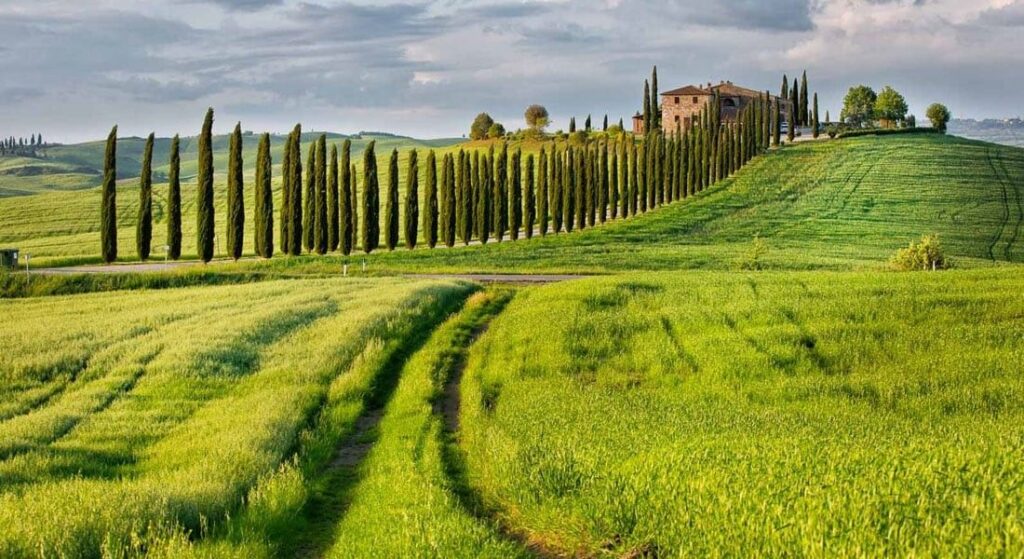
Nestled in the southern part of Tuscany, Val d’Orcia is a UNESCO World Heritage site famous for its breathtaking landscapes, charming medieval towns, and world-class food and wine. With its gently rolling hills dotted with cypress trees, golden wheat fields, and rustic farmhouses, Val d’Orcia embodies the quintessential Tuscan postcard scene. It’s a serene and soulful destination where nature, history, and culture blend seamlessly.
🌟 Highlights of Val d’Orcia
• 🏰 Pienza
Known as the “ideal Renaissance town,” Pienza is a beautifully preserved gem with stunning views over the valley. Wander its quaint streets, visit the Pienza Cathedral, and don’t miss tasting local pecorino cheese in one of the cozy shops or trattorias.
• 🌿 Montalcino
Famous worldwide for producing the prestigious Brunello di Montalcino wine, this hilltop town offers castle tours, wine tastings, and panoramic views that stretch across vineyards and olive groves.
• 🏞️ San Quirico d’Orcia
A charming medieval town with picturesque gardens like Hortus Oasis, ancient churches, and peaceful piazzas—perfect for a slow stroll and coffee break.
• 🚜 Scenic Drives & Photo Stops
The winding roads of Val d’Orcia are legendary for their postcard-perfect views: endless rows of cypress trees, golden fields, and historic farmhouses. Don’t miss the iconic Cappella della Madonna di Vitaleta, a tiny chapel framed by cypresses.
• 🍷 Wine & Olive Oil Tasting
Sample Brunello, Rosso di Montalcino, and local olive oils at family-run farms and wineries scattered across the valley. Many offer tours where you can learn about traditional Tuscan agriculture.
🚗 How to Get There
• By Car:
The best way to explore Val d’Orcia is by renting a car. From Siena or Florence, scenic routes through the Tuscan countryside lead you into the heart of the valley. Roads can be narrow and winding, so take your time and enjoy the journey.
• By Tour:
Guided day trips from Florence or Siena are available, combining visits to Pienza, Montalcino, and other highlights with wine tastings and local food.
🕒 Visitor Information
• Best Time to Visit:
– Spring (April–June) and Fall (September–October) offer mild weather, vibrant colors, and harvest festivals.
– Summer can be warm but is lively with outdoor events and festivals.
• Time Needed to Explore:
Spend at least 2-3 days to fully appreciate the towns, landscapes, and gastronomic delights.
💡 Travel Tips
• 👟 Comfortable Shoes:
Explore medieval streets and countryside trails—good walking shoes are essential.
• 🍽️ Try Local Specialties:
Pici pasta with wild boar sauce, pecorino cheese, and crostini with local spreads are must-tries.
• 🍷 Book Tastings in Advance:
Many wineries require reservations, especially during harvest season.
• 📸 Best Photo Spots:
Sunrise and sunset cast magical light over the rolling hills and cypress-lined roads—perfect for photography lovers.
Val d’Orcia is a timeless Tuscan treasure, where every vista feels like a painting and every meal celebrates local tradition. It’s a place to unwind, breathe in nature, and immerse yourself in authentic Italian life. Whether you’re wandering ancient streets, sipping Brunello on a sunlit terrace, or chasing the perfect sunset, Val d’Orcia promises an unforgettable Tuscan escape.
Arezzo
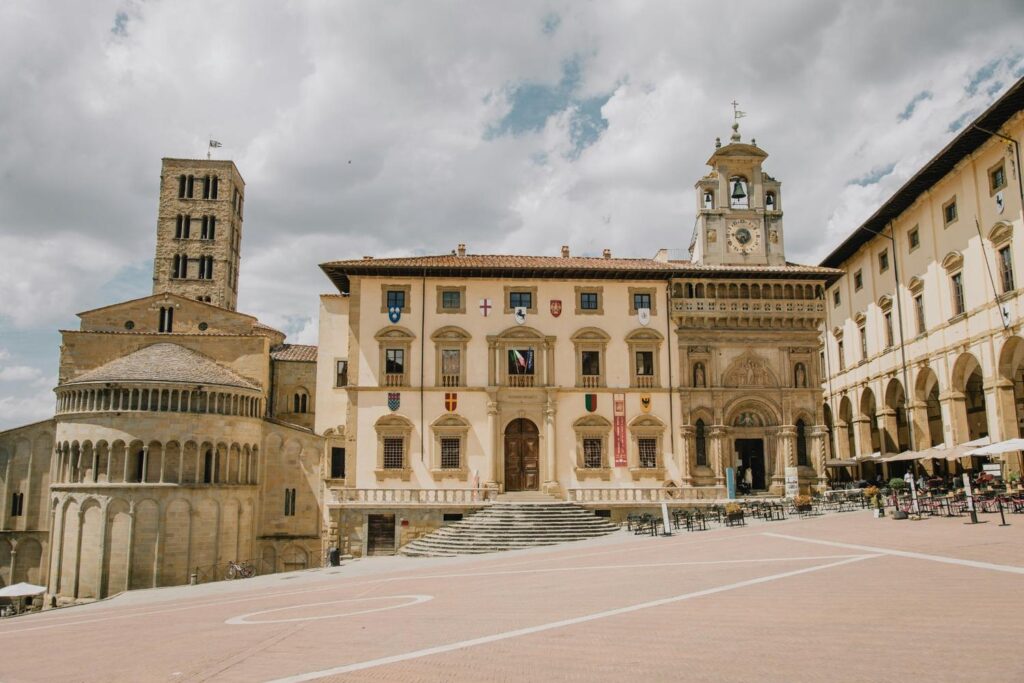
Photo by Alexander Henke on Unsplash
Nestled in the heart of Tuscany, Arezzo is a captivating city that beautifully blends rich history, Renaissance art, and vibrant local culture. Known for its charming medieval streets, lively markets, and stunning churches, Arezzo offers visitors an authentic Tuscan experience away from the more crowded tourist spots. Whether you’re an art lover eager to see Piero della Francesca’s masterpieces or a foodie ready to indulge in local flavors, Arezzo invites you to discover Tuscany’s timeless beauty.
🌟 Highlights of Arezzo
• 🎨 Piero della Francesca Frescoes:
The Basilica of San Francesco houses the famous Legend of the True Cross fresco cycle, painted by the Renaissance master Piero della Francesca. These masterpieces are among Italy’s most important artworks and a must-see for art enthusiasts.
• ⛪ Arezzo Cathedral (Cattedrale di San Donato):
This Gothic cathedral features stunning stained-glass windows and impressive artworks, including a fresco by Piero della Francesca and sculptures by famous artists such as Bartolomeo della Gatta.
• 🏛️ Piazza Grande:
The heart of Arezzo, this uniquely sloped square hosts the famous medieval market, outdoor cafes, and the spectacular Palazzo della Fraternita dei Laici with its astronomical clock.
• 🏺 Roman Amphitheater and Archaeological Museum:
Arezzo’s Roman past is visible in its well-preserved amphitheater, and the museum nearby showcases artifacts from the city’s ancient history.
• 🎉 Giostra del Saracino:
This thrilling medieval jousting tournament takes place twice a year in Piazza Grande, drawing locals and tourists alike to celebrate Arezzo’s traditions.
🚶 How to Get There
• By Train:
Arezzo is easily accessible by train, with frequent connections from Florence (about 1 hour) and Rome (approximately 2.5 hours). The train station is a short walk from the city center.
• By Car:
Located along the A1 highway, Arezzo is convenient for road trips through Tuscany. Parking is available near the historic center.
• By Bus:
Regional buses connect Arezzo to nearby towns and rural areas, though the train is generally faster and more comfortable.
🕒 Visitor Information
• Best Time to Visit:
- Spring and early Fall provide pleasant weather and fewer crowds.
- The Giostra del Saracino takes place in June and September, offering an exciting cultural experience.
• Opening Hours:
- Most museums and churches open between 9:00 AM and 7:00 PM, with variations seasonally.
- Local shops often close in the afternoon for a siesta.
• Time to Explore:
A full day is ideal to explore Arezzo’s main sights, with extra time for the markets or a leisurely meal.
💡 Travel Tips
• 📸 Capture the Views:
Climb the medieval towers or stroll along the old city walls for panoramic views of Arezzo’s rooftops and surrounding Tuscan hills.
• 🍝 Taste Local Cuisine:
Try Arezzo’s specialties like crostini toscani (chicken liver pâté on toasted bread), pici pasta, and wild boar ragù.
• 🛍️ Shop the Antique Market:
Held on the first Sunday of every month and the preceding Saturday, the Arezzo Antique Fair is one of Italy’s largest, perfect for unique souvenirs.
• 🎭 Attend Local Festivals:
Besides the Giostra, explore seasonal events like the Arezzo Wave music festival or traditional religious celebrations.
• 🚶 Wear Comfortable Shoes:
The medieval streets are charming but often cobbled and uneven.
Arezzo may not be Tuscany’s flashiest city, but its rich art heritage, lively markets, and authentic atmosphere make it a true hidden gem. Whether wandering through its historic streets, marveling at Renaissance masterpieces, or savoring local flavors, Arezzo offers a deep and rewarding Tuscan experience far from the typical tourist trails. This city warmly welcomes visitors seeking history, culture, and genuine Italian charm.
Cortona
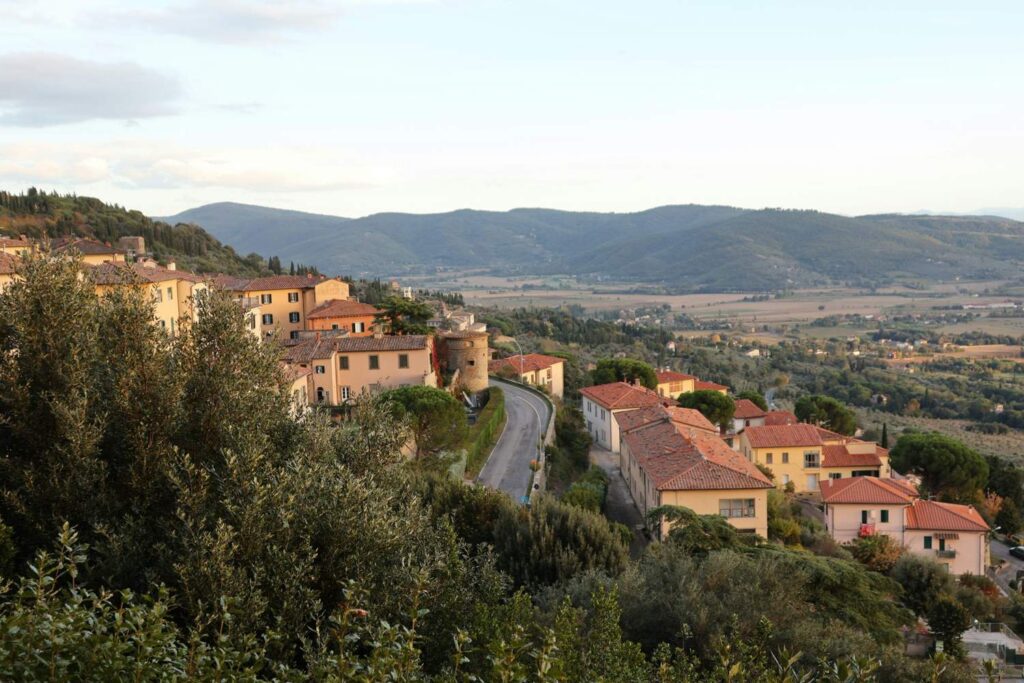
Photo by Meg von Haartman on Unsplash
Perched atop a hill in southern Tuscany, Cortona is a timeless town brimming with history, art, and breathtaking views over the Val di Chiana. Once an important Etruscan settlement, today Cortona blends ancient ruins, medieval streets, and lively piazzas into a perfect Tuscan escape. Known for its vibrant cultural scene and warm local hospitality, Cortona offers a quieter, authentic alternative to Tuscany’s busier hotspots.
🌟 Highlights of Cortona
• 🏛️ Piazza della Repubblica
The heart of Cortona, this lively square buzzes with cafés, shops, and stunning views. It’s the perfect place to soak up local life and watch the sunset over the valley.
• 🏰 Fortezza Medicea
This 16th-century fortress sits atop the town, offering panoramic views stretching over Lake Trasimeno and the surrounding hills. Walk the fortress walls for some of the best photo opportunities.
• 🖼️ Museo dell’Accademia Etrusca
Explore one of Italy’s most important Etruscan museums, housing ancient artifacts, sculptures, and inscriptions that tell the story of Cortona’s pre-Roman past.
• ⛪ Santa Margherita Sanctuary
A peaceful pilgrimage site located just outside town, it’s a beautiful spot for contemplation and enjoying nature’s calm.
• 🍝 Local Cuisine
Taste Cortona’s traditional dishes like pici pasta with wild boar sauce, truffles, and hearty Tuscan stews in family-run trattorias.
🚗 How to Get There
• By Car:
Cortona is best reached by car, with easy access from Florence (about 1.5 hours), Siena, and Arezzo. The drive offers scenic countryside views along winding roads.
• By Train & Bus:
Take a train to Camucia-Cortona station, just below the town, then a short bus or taxi ride uphill.
🕒 Visitor Information
• Best Time to Visit:
– Spring (April–June) and Fall (September–October) are ideal for pleasant weather and fewer crowds.
– Summer brings festivals and vibrant street life but can be warm.
• Time Needed to Explore:
A full day lets you enjoy main sites and soak in the atmosphere; 2 days or more is great if you want to explore nearby villages and countryside trails.
💡 Travel Tips
• 👟 Wear Comfortable Shoes:
Cortona’s steep streets and cobblestones call for sturdy, comfortable footwear.
• 🎨 Check Local Events:
Cortona hosts art exhibitions, concerts, and festivals throughout the year—plan ahead to catch these vibrant cultural moments.
• 🍷 Wine Tasting:
Nearby vineyards produce excellent Toscano IGT wines. Many agriturismi offer tastings and farm-to-table meals.
• 📸 Best Photo Spots:
Sunset from the Fortezza or along the town’s ancient walls provides spectacular views over the Tuscan and Umbrian landscapes.
Cortona is a captivating blend of history, culture, and natural beauty—a Tuscan hill town that invites you to slow down and savor life. Whether wandering ancient streets, enjoying local wines, or watching sunsets over the valley, Cortona offers a peaceful yet inspiring Tuscan experience away from the crowds.
Elba Island
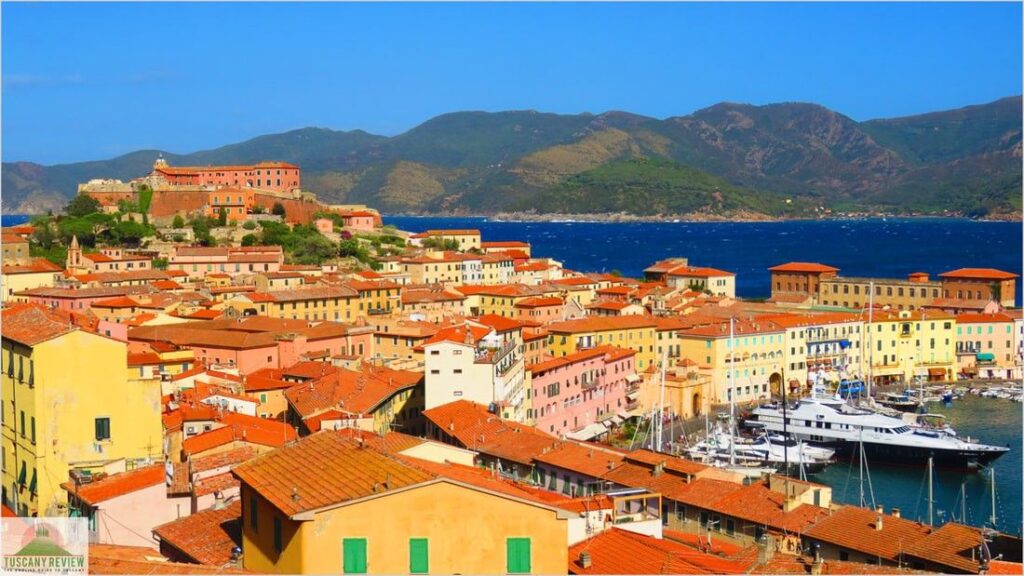
Elba Island is a stunning jewel nestled in the Tyrrhenian Sea, just off the coast of Tuscany. Famous as Napoleon’s place of exile, this island blends rich history, crystal-clear waters, and unspoiled nature. Whether you’re craving pristine beaches, scenic hiking trails, or charming seaside villages, Elba offers a peaceful retreat with authentic Italian vibes and Mediterranean beauty.
🌟 Highlights of Elba Island
• 🏖️ Beautiful Beaches:
Elba boasts over 150 beaches, ranging from golden sands to secluded coves. Popular spots include Spiaggia di Fetovaia, known for its turquoise waters and soft sand, and Cala Giovanna, a perfect hideaway for snorkeling enthusiasts.
• 🏰 Napoleon’s Residences:
History buffs can visit Villa dei Mulini and Villa San Martino, the two elegant residences where Napoleon Bonaparte lived during his exile from 1814 to 1815. These museums offer fascinating insights into his life on the island.
• 🌿 Nature and Hiking:
The island’s interior is rich with hiking trails through Mediterranean scrub, pine forests, and rugged hills. The Monte Capanne hike leads to the island’s highest peak, offering panoramic views over Elba and the surrounding sea.
• 🚤 Water Activities:
Elba is perfect for snorkeling, scuba diving, and sailing. The clear waters around the island teem with marine life and dramatic underwater caves.
• 🏘️ Charming Villages:
Explore picturesque towns like Portoferraio (the main port), Capoliveri, and Marciana Marina, each with cobbled streets, vibrant markets, and excellent seafood restaurants.
🚶 How to Get There
• By Ferry:
Ferries run regularly from Piombino on the Tuscan mainland to Portoferraio and other ports on Elba. The crossing takes about 40 minutes.
• By Plane:
Elba has a small airport (Marina di Campo Airport) with seasonal flights connecting to major Italian cities.
• By Car or Bike:
Bringing a car or renting a scooter is ideal for exploring Elba’s varied landscapes at your own pace.
🕒 Visitor Information
• Best Time to Visit:
- Late spring through early fall (May to September) offers warm weather perfect for beaches and outdoor activities.
- July and August can be busy but lively, while June and September provide a quieter experience.
• Opening Hours:
- Museums and historical sites typically open from 9:00 AM to 6:00 PM.
- Shops and restaurants may close for a midday break but reopen in the evening.
• Time to Explore:
Plan for at least 3-4 days to enjoy Elba’s beaches, nature, and history without rush.
💡 Travel Tips
• 🏄♂️ Bring Snorkeling Gear:
The underwater world around Elba is spectacular. Bring or rent snorkeling gear to explore the marine life up close.
• 🍷 Taste Local Cuisine:
Try cacciucco (a traditional seafood stew), gurguglione (a vegetable stew), and the island’s excellent wines, especially the Aleatico sweet wine.
• 🚴♀️ Rent a Bike or Scooter:
Elba’s diverse terrain is perfect for cycling enthusiasts looking to explore beyond the beaches.
• 📸 Capture Sunset Views:
The west coast, particularly near Capoliveri, offers breathtaking sunsets over the sea—ideal for photography lovers.
• 🌿 Respect Nature:
Elba’s natural beauty is protected by parks and reserves; stick to marked trails and avoid disturbing wildlife.
Elba Island is a captivating blend of history, natural beauty, and laid-back island life. From its pristine beaches and hiking trails to its Napoleon-linked heritage and delicious cuisine, Elba invites travelers to unwind and explore at their own pace. Whether you’re seeking adventure or relaxation, this Tuscan island paradise leaves a lasting impression
🗓️ Best Time to Visit Tuscany
Tuscany is beautiful year-round, but some months offer better experiences depending on your travel style.
- Spring (April to June): Ideal weather, blooming landscapes, and fewer tourists. Great for outdoor exploration.
- Fall (September to October): The best time for wine harvests and truffle festivals. Mild temperatures and golden countryside.
- Summer (July to August): Warm and sunny, but also peak tourist season and very hot inland. Coastal towns are lively.
- Winter (November to March): Quieter and cooler, but perfect for budget travel and enjoying Tuscany’s cities without crowds.
👉 Best Overall Time: Late spring (May–June) and early fall (September–October) for perfect weather, fewer crowds, and vibrant seasonal events.
💶 Currency in Tuscany
- Tuscany, like the rest of Italy, uses the Euro (€).
- Credit and debit cards are accepted widely, especially in cities and tourist spots.
- For small towns, markets, or rural areas, it’s handy to carry some cash.
- ATMs are widely available and easy to use with international cards.
🧳 Travel Tips for Visiting Tuscany
- Language: Italian is the official language, but English is commonly spoken in tourist areas.
- Transport: Renting a car is the best way to explore rural Tuscany. Trains are great for cities like Florence, Pisa, and Siena.
- Food & Wine: Embrace the slow food movement! Try ribollita, pecorino cheese, bistecca alla Fiorentina, and of course, local wines.
- Etiquette: A little Italian goes a long way—try “Buongiorno” (Good morning) and “Grazie” (Thank you).
- Safety: Tuscany is generally very safe for travelers, but always stay aware of your surroundings, especially in crowded tourist areas.
💡 Final Thoughts
Tuscany isn’t just a destination—it’s a feeling. Whether you’re sipping wine under the Tuscan sun, getting lost in medieval streets, or watching the sunset over rolling vineyards, the region whispers stories of art, tradition, and beauty.
Slow down. Soak it in. Tuscany is meant to be savored.

I’m Shreyash Mhashilkar, an IT professional who loves building user-friendly, scalable digital solutions. Outside of coding, I enjoy researching new places, learning about different cultures, and exploring how technology shapes the way we live and travel. I share my experiences and discoveries to help others explore new places, cultures, and ideas with curiosity and enthusiasm.

